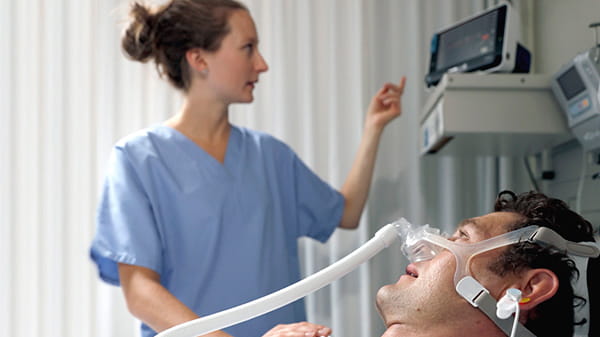Select your destination
Continue to Radiometer Medical
Sleep monitoring solution
Focus on your patients in sleep laboratory from the moment they arrive
You need:
- All devices and sensors set up and working properly before the patient arrives
- The sensors and devices are attached to the patient
- An undisturbed sleep environment for the duration of the study to get the most accurate data possible
- The data recorded and prepared for the physician who makes their diagnosis
Diagnosing your patients in the sleep laboratory
Several research studies point towards transcutaneous monitoring of CO2 being preferable to arterial pCO2 to monitor patients on non-invasive ventilation undergoing sleep studies. [2, 3]
Combined tcpCO2 and SpO2 transcutaneous monitoring helps detect hypoventilation in patients at risk of sleep-related breathing disorders. You can also use transcutaneous monitoring of CO2 on children with breathing problems related to sleep disorders or children with respiratory or congenital diseases [4-6].


Transcutaneous monitoring plays a very important part in making adjustments of invasive and non-invasive ventilator settings for nocturnal monitoring of ventilation status.
- Doctor Raffaele Piumelli, Medical Director Sleep Laboratory Department Meyer Children’s Hospital Florence, Italy


TCM5 BASIC transcutaneous monitor – ready when you are
When it comes to sleep diagnostics, preparation is key. You want all your devices and sensors set up and working properly before the patient arrives.
The TCM5 BASIC transcutaneous monitor helps make preparation easier. Built-in tutorials and a clear, simple user interface simplify setup, usage and troubleshooting.
Automatic sensor calibration reduces preparation time, supporting your workflow in the sleep lab.
References
2.Storre, J. H. et al. Transcutaneous monitoring as a replacement for arterial PCO(2) monitoring during nocturnal non-invasive ventilation. Respiratory Medicine 2011; 105, 1 (2011): 143-150.
3.Aarrestad S. et al. Sleep related respiratory events during non-invasive ventilation of patients with chronic hypoventilation. Respiratory Medicine 2017; 132: 210-216.
4.Gerdung C. A., Adeleye A., Kirk V. G. Noninvasive monitoring of CO2 during polysomnography: a review of the recent literature. Curr Opin Pulm Med 2016; 22, 6: 127-134.
5.Amaddeo A., Fauroux B. Oxygen and carbon dioxide monitoring during sleep. Paediatric Respiratory Reviews 2016; 20: 42-44.
6.Corbelli R., Michelet M., Barazzone-Argiroffo C. Respiratory polygraphy data of children investigated for sleep-disordered breathing with different congenital or respiratory diseases. Data in brief 2020; 31
Cookies are used on this website
Use of cookiesPlease enter a valid email
We will be sending an e-mail invitation to you shortly to sign in using Microsoft Azure AD.
It seems that your e-mail is not registered with us
Please click "Get started" in the e-mail to complete the registration process
Radiometer is using Microsoft AZURE Active Directory to authenticate users
Radiometer uses Azure AD to provide our customers and partners secure access to documents, resources, and other services on our customer portal.
If your organization is already using Azure AD you can use the same credentials to access Radiometer's customer portal.
Key benefits
- Allow the use of existing Active Directory credentials
- Single-sign on experience
- Use same credentials to access future services
Request access
You will receive an invitation to access our services via e-mail when your request has been approved.
When you accept the invitation, and your organization is already using AZURE AD, you can use the same credentials to access Radiometer's customer portal. Otherwise, a one-time password will be sent via e-mail to sign in.
